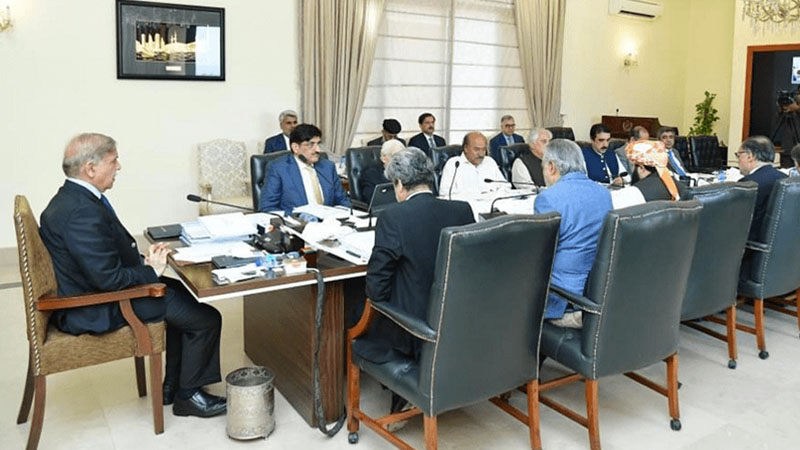Today, the newly constituted National Economic Council (NEC) will convene to review ongoing and future investments and set economic targets for the next fiscal year. The council aims for a 3.6 per cent growth rate amid the planning division’s push to increase the federal Public Sector Development Programme (PSDP) to Rs1.5 trillion, up from the Rs1.22 trillion recommended by the Annual Plan Coordination Committee (APCC) last week.
The NEC, led by Prime Minister Shehbaz Sharif, is the highest constitutional body for economic policymaking in Pakistan. Its 13 members include the four provincial chief ministers, four federal ministers (foreign affairs, defense, finance, and planning), and four provincial cabinet members.
Today’s meeting will address a six-point agenda, including a review of the 2023-24 macroeconomic framework and the approval of priorities and targets for 2024-25. Additionally, the council will consider the 13th five-year plan (2024-29) and approve it for implementation. It will also evaluate the implementation status of the current year’s public investment programme and approve the investment plan for the next fiscal year, which envisions almost Rs4 trillion in development spending by the federal and provincial governments.
The APCC has cleared a national investment plan worth approximately Rs2.869 trillion, including Rs1.22 trillion for the PSDP, with annual development plans (ADPs) of Rs700 billion for Punjab, Rs763 billion for Sindh, and Rs627 billion for Khyber Pakhtunkhwa. Balochistan’s ADP will also be finalised during the NEC meeting, given its limited resources and high dependence on federal transfers.
Punjab has reportedly planned a significantly higher ADP than initially indicated, potentially matching the federal PSDP. The power sector will also show an allocation of Rs185 billion for development projects from its own resources generated under Nepra’s approval. Consequently, the overall national development plan for the next fiscal year is expected to surpass Rs4 trillion.
The NEC will also review the performance reports of the Executive Committee of the National Economic Council (Ecnec) and the Central Development Working Party (CDWP) for the outgoing fiscal year, including the implementation of decisions taken by these bodies. Additionally, the council will consider a report on the performance of state-owned entities.
Sources indicate that the Ministry of Planning is still advocating for a PSDP of Rs1.5 trillion for 2024-25, contrary to the Rs1.221 trillion approved by the APCC. They argue that some critical areas were overlooked by the APCC, and there are additional demands from coalition partners that the planning minister and prime minister are likely to accommodate.
A senior government official commented, “Aiming for higher PSDP investment is beneficial, although its implementation will depend on actual resource availability during the fiscal year.”
The growth target for the next fiscal year is proposed at 3.6pc, supported by 2pc growth in agriculture, 4.4pc in industry, and 4.1pc in services. These growth prospects hinge on political stability, exchange rate stability, macroeconomic stabilisation under the IMF programme, and expected declines in global oil and commodity prices, according to the Planning Commission.
The agricultural sector’s 2pc growth target reflects a substantial contraction due to severe dry weather and inadequate water availability, particularly affecting kharif crops. Other crops and livestock sub-sectors are projected to grow by 4.3pc and 3.8pc, respectively.
The industrial sector is expected to recover with a targeted growth of 4.4pc, driven by an anticipated 3.5pc growth in large-scale manufacturing (LSM). This recovery is attributed to improved inputs and energy supplies, easing import restrictions, higher public sector expenditure, exchange rate stability, and lower interest rates. These factors are expected to reduce construction material prices, supporting a 5.5pc growth target for the construction industry in 2024-25.
The services sector is projected to grow by 4.1pc, bolstered by the expected 3.1pc growth in commodity -producing sectors. Increased economic activity in the industrial and manufacturing sectors will drive growth in wholesale and retail trade, transport, storage, and communications.
The investment-to-GDP ratio is expected to rise from 13.1pc in 2023-24 to 14.2pc in 2024-25, reflecting an improved business environment and political stability. Fixed investment is projected to grow by 27.6pc on a nominal basis, increasing from 11.4pc to 12.5pc of GDP. National savings are targeted at 13.3pc of GDP for 2024-25, up from 13pc this year.
The government anticipates a narrowing fiscal deficit through fiscal consolidation measures, focussing on enhancing tax revenue and curtailing non-development expenditures, including subsidies. Monetary policy will aim to balance inflationary expectations and growth revival. With global inflation falling, domestic inflation is expected to moderate to 12pc next year.
